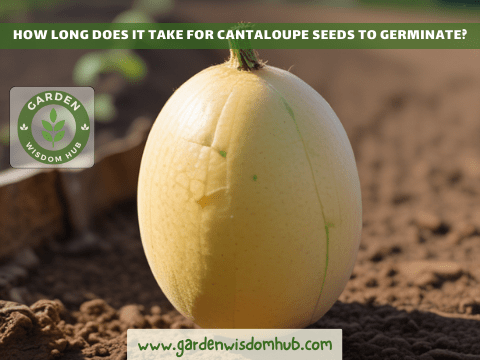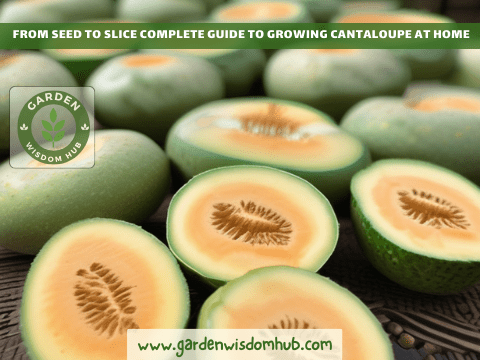How do cantaloupes grow?
Growing cantaloupes from seeds is like starting a yummy journey. Whether you are experienced or new to gardening, it is worth every moment. With some passage of time, you will see growing changes in vines as well as the formation of sweet fruit. So, get ready to dive in and enjoy the delightful rewards from nature’s end.
The cantaloupe is a unique fruit, different from its related group, the honeydew. When it is fully ripened, it not only smells fantastic, but a delicious change in taste occurs as well. The prominent popularity of cantaloupe in salads and desserts is quite remarkable.
The seeds can stay worthwhile for up to four years, ready to grow into new plants. Nature’s wonders can be seen in this simple fruit by this natural process of seeds. Imagine biting into a juicy slice of sweet cantaloupe, making a mess of sweetness and delightfulness. The excitement of eating these juicy cantaloupes increases when you come to know that they are from your garden.
- Read up on our comprehensive article about The Complete Guide to Cantaloupe: Facts, Growing, and Varieties
Growing cantaloupe from seed
Many people wonder how to grow cantaloupe from fresh seeds. Growing cantaloupe from seed is easy, but they need enough space to grow. Homegrown goodness brings simple joys. Cantaloupes are of two types:
- Eastern
- Western
Eastern ones are big but can’t last that long, while Western ones are smooth and last relatively longer. Some cantaloupes are ripening quickly, while others take their time. Cantaloupes are truly unique fruits with matchless experiences.
- Read up on our comprehensive article about Understanding Cantaloupe Growth Stages and Care
Can you plant cantaloupe seeds?
In a garden full of cantaloupes, where small fruits climb trellises effortlessly. On the other hand, big ones need support, which can be in the form of a cloth hammock. Cantaloupes need warmth and sunlight for their successful growth. Give them enough space to spread themselves out on trellises. With the proper precautions and enough sunshine, growing cantaloupe is not that difficult at all.
Germinating cantaloupe seedlings
Just imagine how many changes occur in just one season to a cantaloupe plant. It takes around 75 days for the vines to go from seed to harvest after they have spread across fields. Cantaloupes are widely produced since it is a seasonal cycle in which seeds are planted, and fruits are harvested. Season serves as a dance partner in the natural growth of cantaloupes.
How to prepare cantaloupe seeds for planting?
Cantaloupe plants begin to mature at a rapid rate when the weather heats up. You don’t have to use containers to start seedlings in warm climates. They can be reduced gradually by transplanting them. However, for regions with less frequent frosts, it is best to start sowing seeds indoors around one month before to the last frost. Their healthy growth ensures a bountiful crop.
Can you grow cantaloupe indoors or outdoors?
It is easy to turn the outdoor area of your apartment into a paradise for cantaloupe plants. It would help if you chose for a container that has good drainage and an area with sunlight. To prevent the roots from becoming wet, layer the bottom with pumice or nutshell shavings. Compost and sandy dirt should be used to fill it. Sow your cantaloupe seedling, and make sure to give it plenty of water. Climbing is what cantaloupes enjoy the most, so placing a trellis for them can play a major role in their growth.
By putting enough effort and the right amount of sunshine on your deck, you will soon be able to smell the delicious aroma of cantaloupes.
Sowing cantaloupe seeds
The cantaloupe, or muskmelon, can be tricky for one to figure out. Some muskmelons are not cantaloupes but are all muskmelons to some people. But you don’t have to worry, though; there are a lot of different kinds of melons in your yard. If you want a standard cantaloupe with orange meat and a netted peel, you can go for any of these types:
- Sugar Cube: This small, tasty plant is great for vines and doesn’t get diseases readily.
- Athena is known for its deep orange meat, which doesn’t get sick quickly.
- Minnesota Midget: Small as well as hardy, this breed is excellent for spots with little space or that are cooler.
- Hale’s Best Jumbo: Firm meat that is sweet, juicy, and smells lovely.
- Sarah’s Pick: Sweet, petite to medium-sized melons with a pleasing smell. This mix of melons has something for every plant and taste.
- Watch this YouTube Video For More Guide Related to Growing cantaloupe at home large and sweet fruit
How to germinate cantaloupe seeds and how long it takes for cantaloupe seeds to germinate?
In order to start cantaloupe seedlings indoors, sow your seeds into sterilized seed establishing mix in large seedling pots, large soil blocks, or large opening seedling trays about four weeks before the last frost date as cantaloupe seedlings grow large quickly. Large cantaloupe seeds should be planted about 1/2 inch deep when sown. To ensure that at least one seed germinates, we prefer to plant two to three seeds in each spot.
Keep the seedlings warm and hydrate them enough. The optimal soil temperature range for cantaloupe seed germination is about 75° to 85°F. To achieve the right temperature while starting melon seeds inside, the majority of people will use a seed starting mat.
After they have emerged, give the seedlings regular warmth and moisture. They’ll increase, cut off the rest to save the strongest seedling in each cell with tiny snips. Plant the cantaloupe seedlings 36″ apart in the garden following the date of your last frost.
How to grow and care for melon seeds?
Once cantaloupe plants have established themselves, it is not that difficult to care for them. Every week, give them about an inch of water or more if the outside temperature is high. Warm and wet soil can be maintained with the help of organic mulch, such as straw or leaves.
You can water cantaloupe using soaker hoses, drip irrigation, or by hand. Avoid using sprinklers during humid summers to prevent mildew. Fertilize melon plants lightly if your bed has good compost and organic matter. When dealing with pests like cucumber beetles and squash bugs, related plants should be used as a shield. Fragrant flowers like tansy, marigolds, and nasturtiums can effectively resist these pests. You can further prevent them by planting garlic, mint, basil, or onions right next to your cantaloupes.
The Cantaloupes plant includes both male and female flowers. Identify the male flowers with straight stems as well as the female flowers with round bases, and make sure to have both the male and female flowers in your garden in order to have a successful outcome. Cantaloupes are ready to be collected when they have a delicious fruity smell and are able to be removed from the vine with minimal effort.
- Read up on our comprehensive article about Cantaloupe and Watermelon: Growing Tips and Differences
How long does it take for cantaloupe seeds to germinate?

You can make your seeds germinate early by following the below-mentioned tips. A few helpful tips for harvesting cantaloupe and increasing its life cycle are as follows:
- It is essential to check your plants on a regular basis once the fruit starts to ripen because they may soon turn overripe.
- You can remove the cantaloupe from the vine by using a sharp knife or pruner, ensuring you leave a short stem behind.
- If you want the cantaloupes to have a longer shelf life, you can either keep them in the refrigerator or at room temperature for a couple of days so that they can ripen even further.
In the journey of beautiful nature, growing cantaloupe from seeds to fruit is a task that can be performed with some patience, love, and effort from your side. By choosing the right kind of cantaloupe plants for your garden, you can obtain ample delicious fruits. Always make it a habit to take care of your plants by taking the right precautions in order to protect them from different diseases.
————————————————————————————————————————————————————-
To learn more about Kitchen Garden Check out Our Guides:
Life Cycle of a Strawberry Plant Exploring the Complete Details
Strawberry Plant Growth Stages The Ultimate Complete Guide
Why are My Basil Leaves Turning Brown?
Guide to Banana Plant Growth Stages
Guide To an Apple Tree Growth Stages
Guide to Turmeric Plant Growth Stages
Guide to Cherry Tomatoes Growth Stages
James Porter
Welcome to our haven of gardening and plant care, where outdoor and indoor planting enthusiasts come together! At Gardening Wisdom Hub, we aim to provide you with the most authentic information on anything related to gardening, plant care, seasonal planting etc.
The author of our website is James Porter, an experienced industry veteran. He has a deep interest in everything green. James’s enthusiasm for exploring plants’ features and learning new gardening methods began at a young age. Gradually, his passion increased with time, leading him to become a highly esteemed professional. His extensive knowledge makes him a priceless resource for inexperienced and seasoned gardeners.

